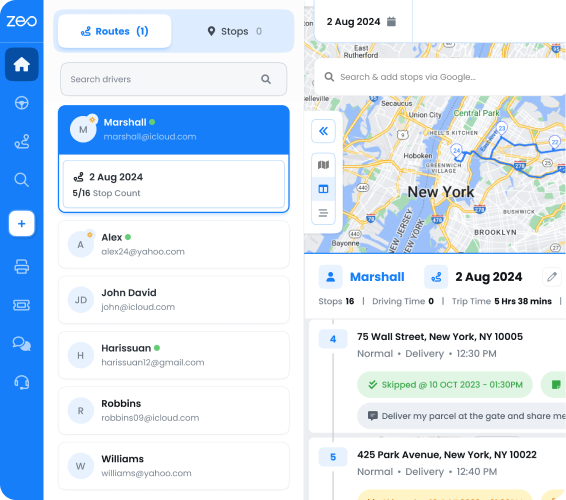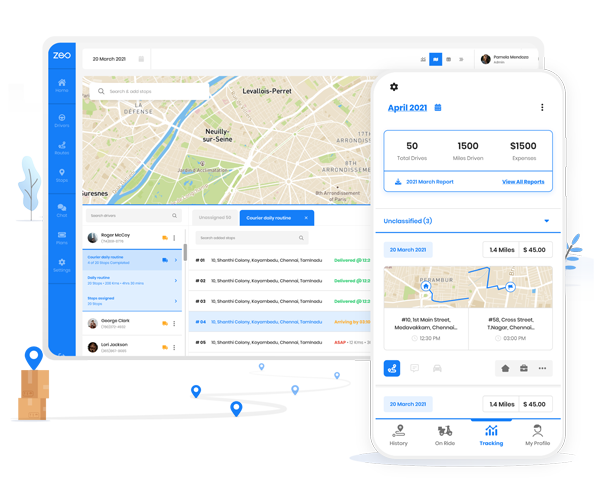Google Maps has a monthly user base of over 154.4 million, making it one of the most popular navigation apps in the U.S. However, given its popularity and usage for navigation, it falls far behind in other attributes like route optimization, data privacy and security, customization, and more.
Through this blog, we will explore the major drawbacks of Google Maps and make a case for why drivers and delivery business owners should refrain from making it a go-to app.
7 Reasons to Move on From Google Maps Route Planner App
-
Limited Number of Stops
Google Maps allows you to add only up to 9 stops in your route. This might make it challenging to plan extensive trips or efficiently navigate through multiple destinations. Whether you’re a delivery driver or a business having complex logistics, this restriction can hinder your delivery process. The limited number of stops may disrupt scheduling, logistics, and convenience. This makes it necessary for users with more extensive routing needs to explore alternative route planner apps.
-
Lack of Optimized Route
While Google Maps provides reliable navigation, it does not offer advanced route optimization capabilities. It won’t present the most efficient routes with multiple stops always. This limitation can be problematic for businesses or individuals who need to plan routes with multiple waypoints or optimize delivery schedules. Without route optimization, users may end up wasting time, fuel, and resources navigating through suboptimal paths.
-
Not Preferred for Unknown Locations
One drawback of relying solely on Google Maps for delivery services is that you have to already know the area. Google Maps does not inherently offer detailed information about location-specific attributes that could affect delivery logistics. Delivery drivers often need to have familiarity with shortcuts, traffic situations, road conditions, parking restrictions, gated communities, or other factors that may impact the efficiency and success of their deliveries.
-
Limited Customization Options
While Google Maps offers various routing options, some users prefer more granular control over their routes. For example, if you want to avoid certain types of roads, prioritize scenic routes, or include specific waypoints, Google Maps does not offer that level of customization. In such cases, specialized route planning apps might be a better fit.
-
Complex to Manage
It can become complex to manage multiple routes, waypoints, or ongoing changes to your routes with Google Maps. It also becomes challenging to keep track of various saved locations, customized routes, and personalized settings. Moreover, if you frequently switch between devices or platforms, synchronizing your data and preferences across multiple devices can be very hectic.
-
Privacy Concerns
Google Maps collects and stores a significant amount of user data, including location history, which some individuals may find intrusive. If you have concerns about your privacy and data security, you must consider an alternative route planner app like Zeo that prioritizes user privacy and data security.
-
Popular Route Bias
Google Maps tends to prioritize popular routes and major highways. This popular route bias can often lead to overcrowding and congestion on high-traffic routes. If you prefer to explore lesser-known roads or scenic routes, using other navigation tools can provide a more tailored experience.
Related Read: Google Maps Route Navigation
Related Read: Top 5 Route Planner Apps

increase fuel savings
Save $200 on fuel, Monthly!
Optimize routes with our algorithm, reducing travel time and costs efficiently.
Get Started for Free
Conclusion
Clearly, Google Maps shouldn’t be the first choice for drivers if they are looking to optimize their routes and save on time and resources. If you are a driver and want to improve your delivery process, it is highly advisable to move on from a basic route planner app like Google Maps and switch to a robust tech-driven route planner app like Zeo. It uses cutting-edge technology and modern-day algorithms to calculate the fastest and most efficient routes based on multiple factors, such as distance, traffic priorities, and time constraints.
Download the app now (Android and iOS) to overcome all the hurdles presented by Google Maps.

Are you a fleet owner?
Want to manage your drivers and deliveries easily?
Grow your business effortlessly with Zeo Routes Planner – optimize routes and manage multiple drivers with ease.

increase fuel savings
Hassle Free Deliveries & Pickups!
Optimize routes with our algorithm, reducing travel time and costs efficiently.
Get Started for Free




















